The art of storytelling is an essential aspect of wedding photography, capturing the unique narrative of a couple’s special day in a way that brings their story to life. The challenge lies in creating a visual representation of the emotions, connections, and fleeting moments that define a wedding day, and doing so in a way that feels genuine, heartfelt and emotive
In this article, I’ll explore the art of storytelling in wedding photography and share tips on how to create a compelling narrative that will resonate with your clients and stand the test of time.
Capturing Emotions
Weddings are a rollercoaster of emotions – from the excitement of getting ready to the nervous anticipation before the ceremony, the joy of seeing each other on the aisle, and the sheer euphoria of the celebrations that follow. As a wedding photographer, your goal is to capture the raw, genuine emotions that define the day, the unrepeatable moments and create a visual narrative that evokes those feelings for years to come.

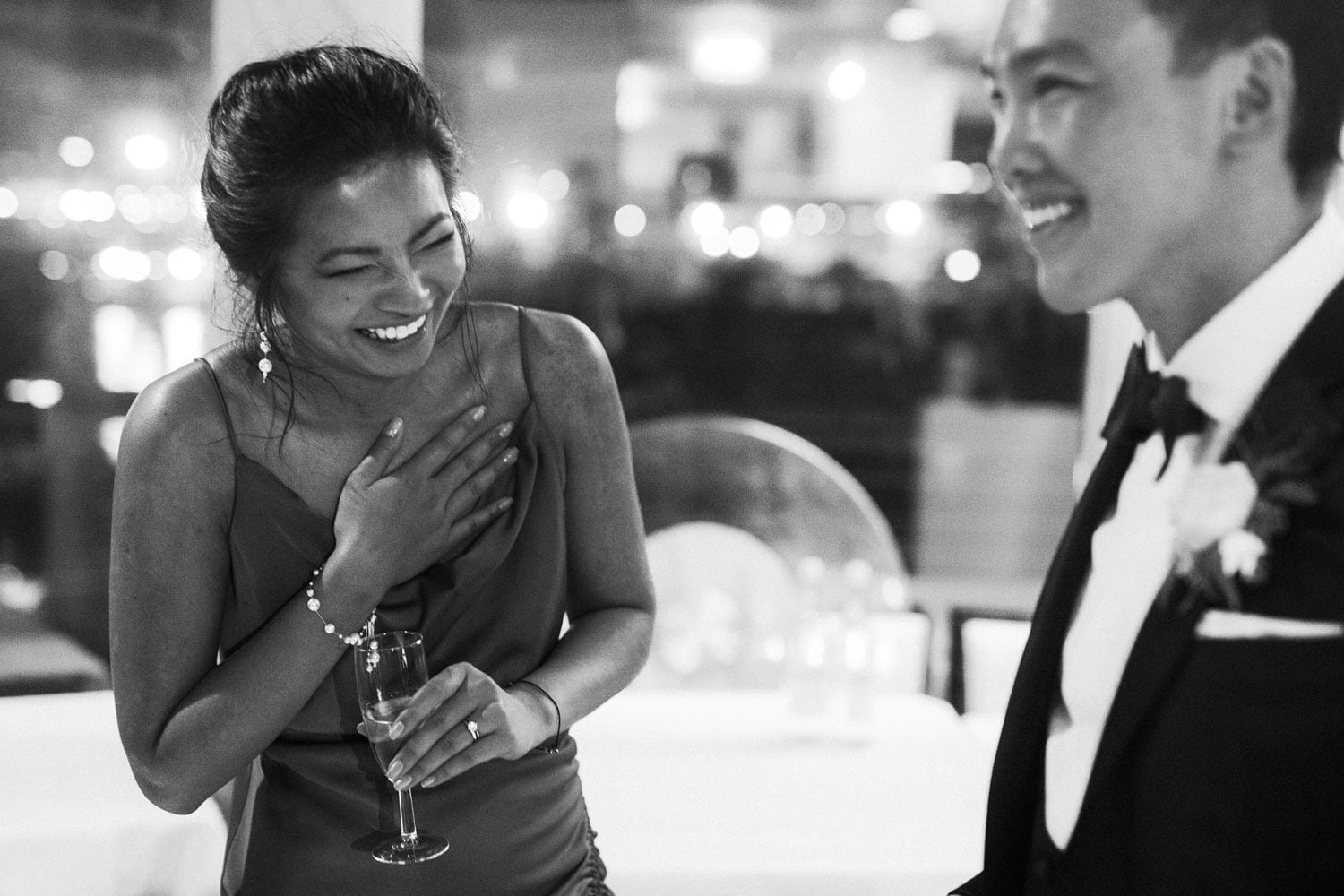
So, how do you do it?
Well, experience is everything, it’s true, but there certainly are tips I can give you to help anticipate the seemingly unpredictable.
You can never know exactly what someone is going to do, that is truly impossible, but what you can do is recognise the ‘scene’ that has been set before and how people often react within the context of those scenes.
“but I’m nervous that people will be weirded out by me taking their picture”
Wedding guests have no context for you as a photographer, they do not know what to expect. If you boldly stand next to a group of people and start taking their picture, they will ignore you, I promise.
If you have conviction then the guests simply assume ‘oh, this is how they do it’, and get on with their day.
It is all in your head. Nobody cares!
Getting ready
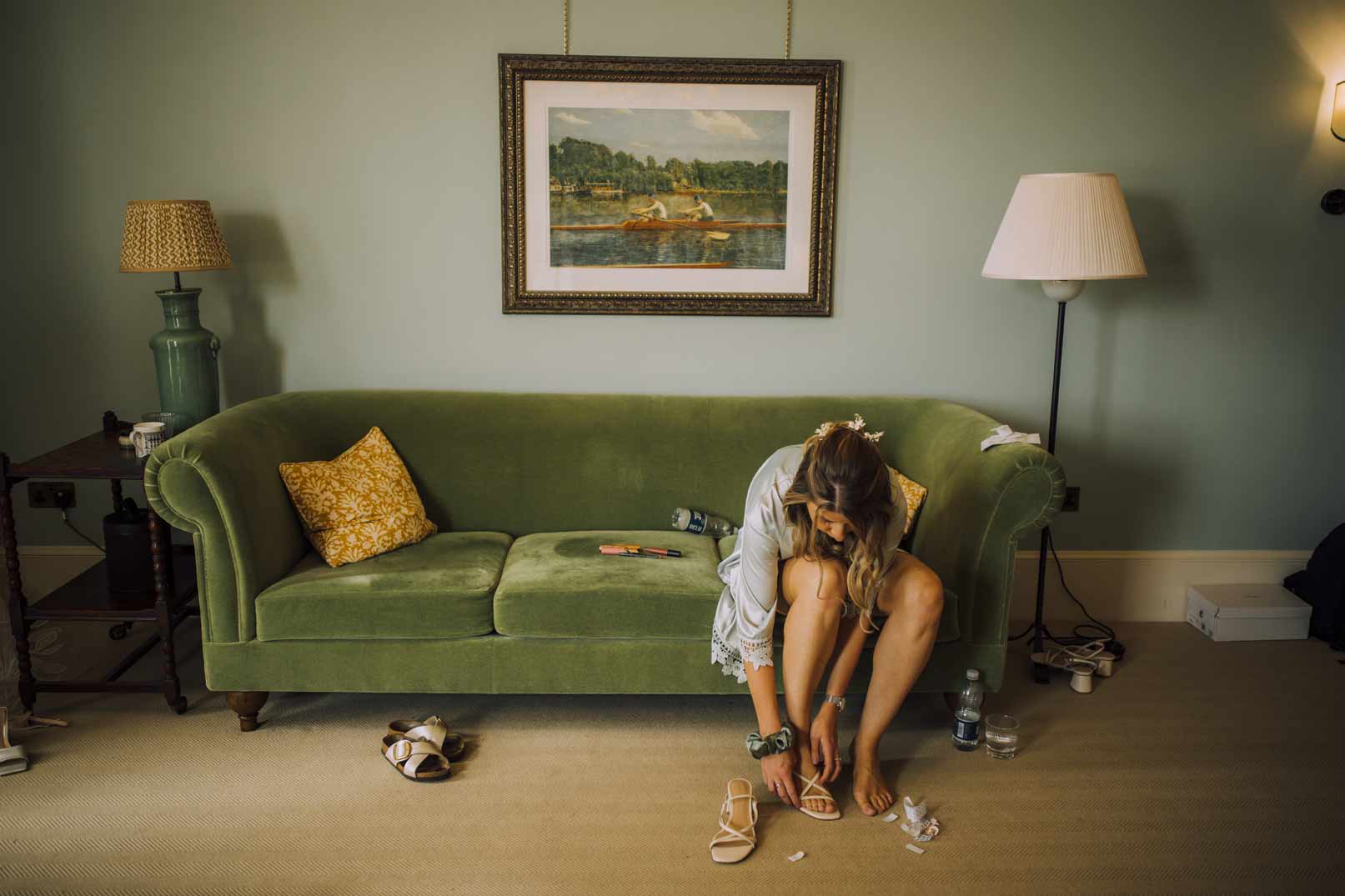
Moments to look out for:
popping of champagne – often overflows
bride reading a card from the groom – ask the bridesmaids if there are any gifts being given so you know you’ll be there when it happens
putting on the veil – for some reason this transforms he look into ‘the bride’, it’s at this point in my experience it all begins to feel ‘real’ and everyone starts crying.
bride reveal – you can stage this if you like, I tend not to if I can, but some brides request ‘a shot of dad as he sees me for the first time’. If they’ve requested it, it’s my job to try and make sure I get that picture. Whilst I don’t like staging, I will tip the odds in my favour. Firstly making sure I know where Dad is so he won’t just burst in. Secondly being ready, positioned looking over the brides shoulder in the direction the dad will appear from.
A note on Dad’s – it’s often when you do the bride reveal that the Dad will smile, but not much else, but keep watching him out of the corner of your eye. It’s a very English thing to not want to be vulnerable, so when he thinks no one is looking is when you can often get a shot of hi crying.
The Ceremony
You want to make sure you’re getting really good pictures of the couple during the ceremony, but assuming you’ve positioned yourself properly, you should be able to see most of the guests to get some epic candid pictures.
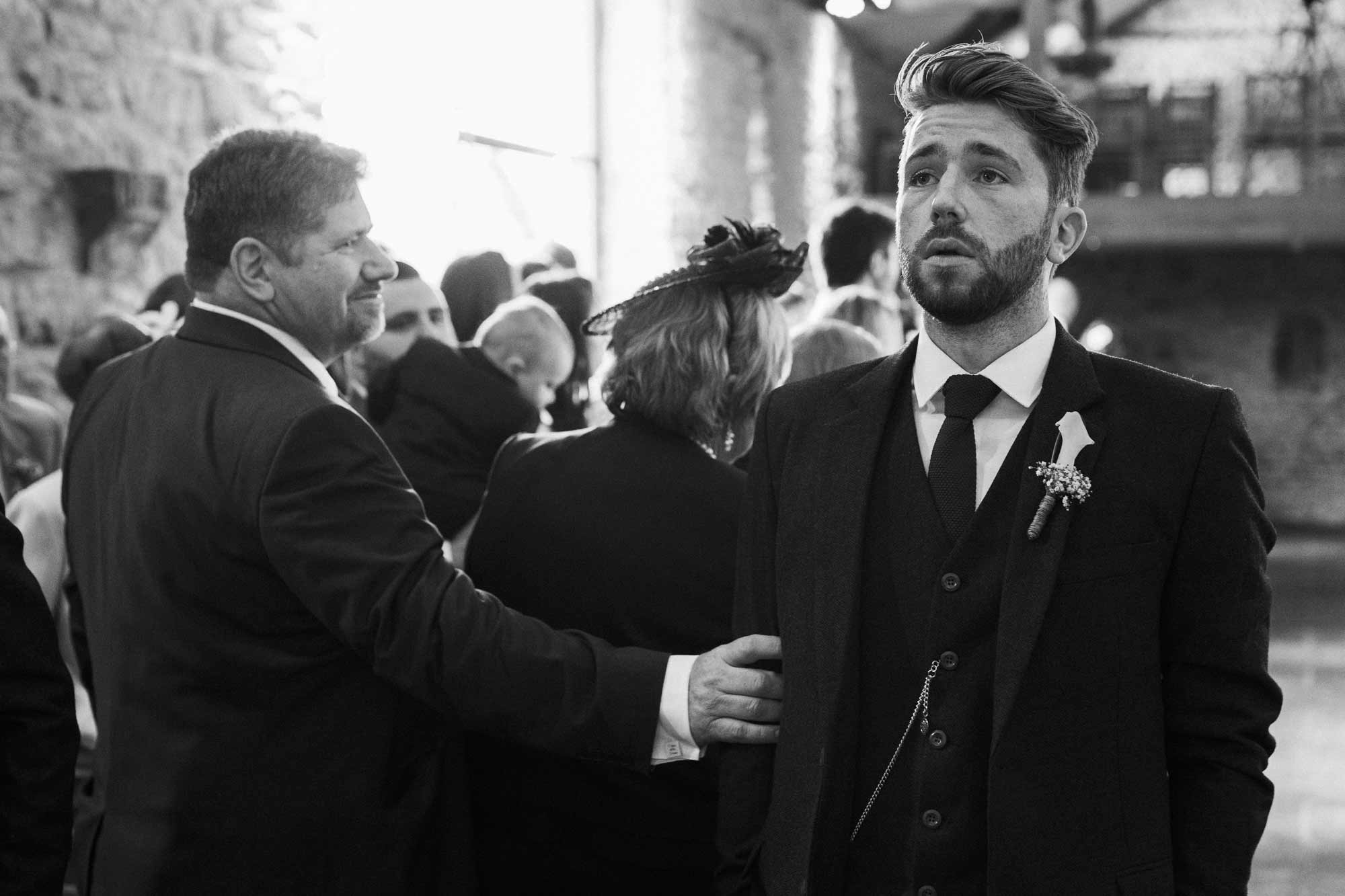
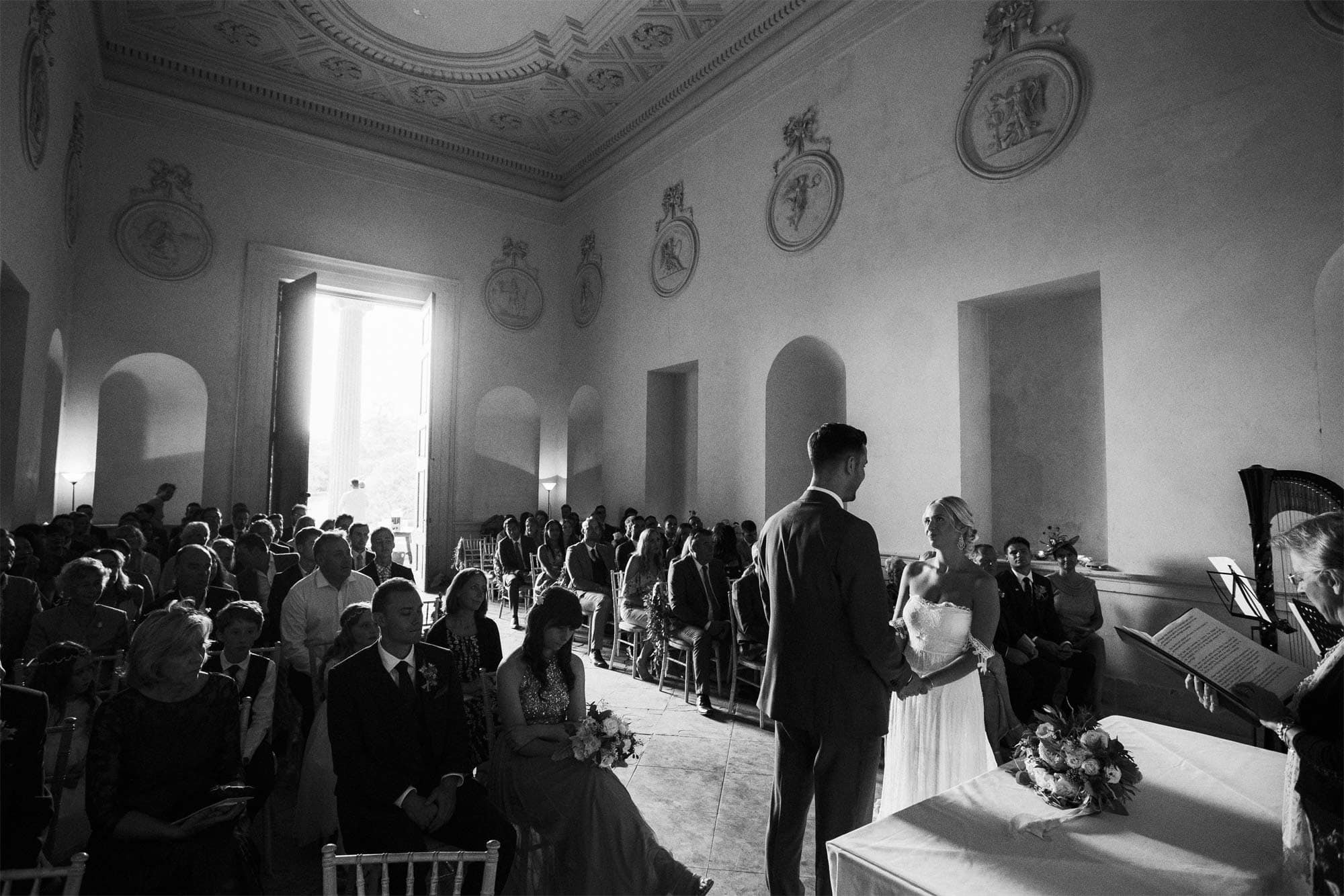
The aisle walk – This is often dictated to you where you can and can’t stand, so don’t annoy the officiant, do as your told. Say hello to them with a warm greeting and then ask what you can and can’t do. Most are lovely and will offer to stay out of your way during the aisle walk. Shooting over the grooms shoulder means you’re in prime position to capture the brides entrance, but then you’re also in the right spot for when she reaches the top of the aisle. If you can , have two lenses, an 85mm or a 50mm on one body, and a wide 24mm on the other body (I use the holdfast money-maker strap for quick changing), this way you can capture the scale of the entrance, and then get the inevitable laughs or tears when the couple meet.
Look past the couple – there will inevitably be one person crying, you often have to be super sharp eyed and speedy to capture them though. The guests form an important part of the day and are an integral part of the story, every now and again, scan the room and see if you can spot someone tearing up.
The ring exchange – I’m not a fan of just focussing on the bride, get in the aisle if you can so then you can see the couple clearly.
The kiss – again this looks wrong to me if it’s shot from a forty five degree angle. If you’re in the aisle for the ring exchange then stay there, maybe back up a few steps to get the front few rows of guests in too.
Signing the register – this is gold for people letting their guard down. Once the couple has signed the register they stand back and seem to completely forget where they are, it’s magic, watch what they do, it’s often something quite sweet and intimate. You can pretend you are photographing the witnesses signing the book but have them in focus in the background to keep yourself inconspicuous.
Post ceremony
Arranging confetti – my top tip – hide the couple. If they are out of site then the group will listen. Arrange the two lines that you need, then when ready get the couple to re-appear. Consult with them before the day the easiest way to do this. It will save you a good twenty minutes. If the bride and groom get immersed in the crowd, pulling them back out again is hard. Best to just get this shot done.
After confetti, the couple are at the front of the group and everyone is looking at them. This can also be an opportune moment to arrange the photograph of everyone (if they want it). Again, your goal is to keep the crowd from forming a line to greet the couple, as soon as that happens it’s hard to pull them away.
Expect lots of hugs and kisses. Pay attention to what people do with their hands. They wipe away tears, touch, embrace, squeeze. Hands can be extremely emotive, close ups here work well in breaking up the story to zero in on an emotion. This bit comes thick and fast as the couple move through the crowd, a wide angle is probably your best bet.
Group pictures and couple portraits
More opportunity for people letting their guard down.
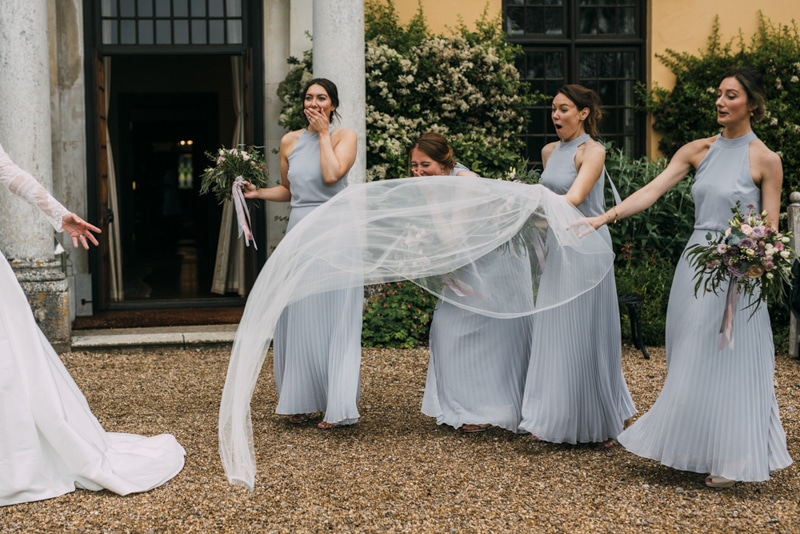
Arrange the group picture, take the shots you need, but when you take the camera away from your eye keep your finger on the trigger. Often, when people think the formal picture is open they ten do something much more relaxed which generates laughs from the couple and the rest of the guests.
During the couple portraits, my top tips here are: get them moving, use your favourite location last and don’t be more than 20 minutes.
People don’t want to pose and they don’t know how to pose, which is good, because posing isn’t real life and tells us nothing of the couple. That being said, we can loosen them up to make sure they are comfortable. The easiest way to do this is to find a spot that they can walk along, a tree lined path or whatever, something where the background is good. When they walk they pay attention to their steps and not you, they relax and the pictures are much more natural. Have them glance at each other and when they get to a spot you like just ask them to stop and face each other and photograph what happens.
By choosing your favourite spot last they will have relaxed by this point and you’ll be in the best location getting the best natural interactions between the couple.
I say don’t take longer than 20 minutes because most people will want to get back to the party and they’ll be bored, if you can’t get it done in this time then something else in your process is wrong.
Don’t worry about it getting awkward, sometimes you have to let the awkwardness rise until they finally let go and be themselves, this can take a while, but you just have to trust the process. Get them talking to each other and say ‘I’m going to shoot this wide, so feel free to chat’. Then increase the distance between you and them, and gradually get closer to them.
Document the Details
The details of a wedding, from the intricate decorations to the carefully chosen attire, contribute to the overall narrative of the day.
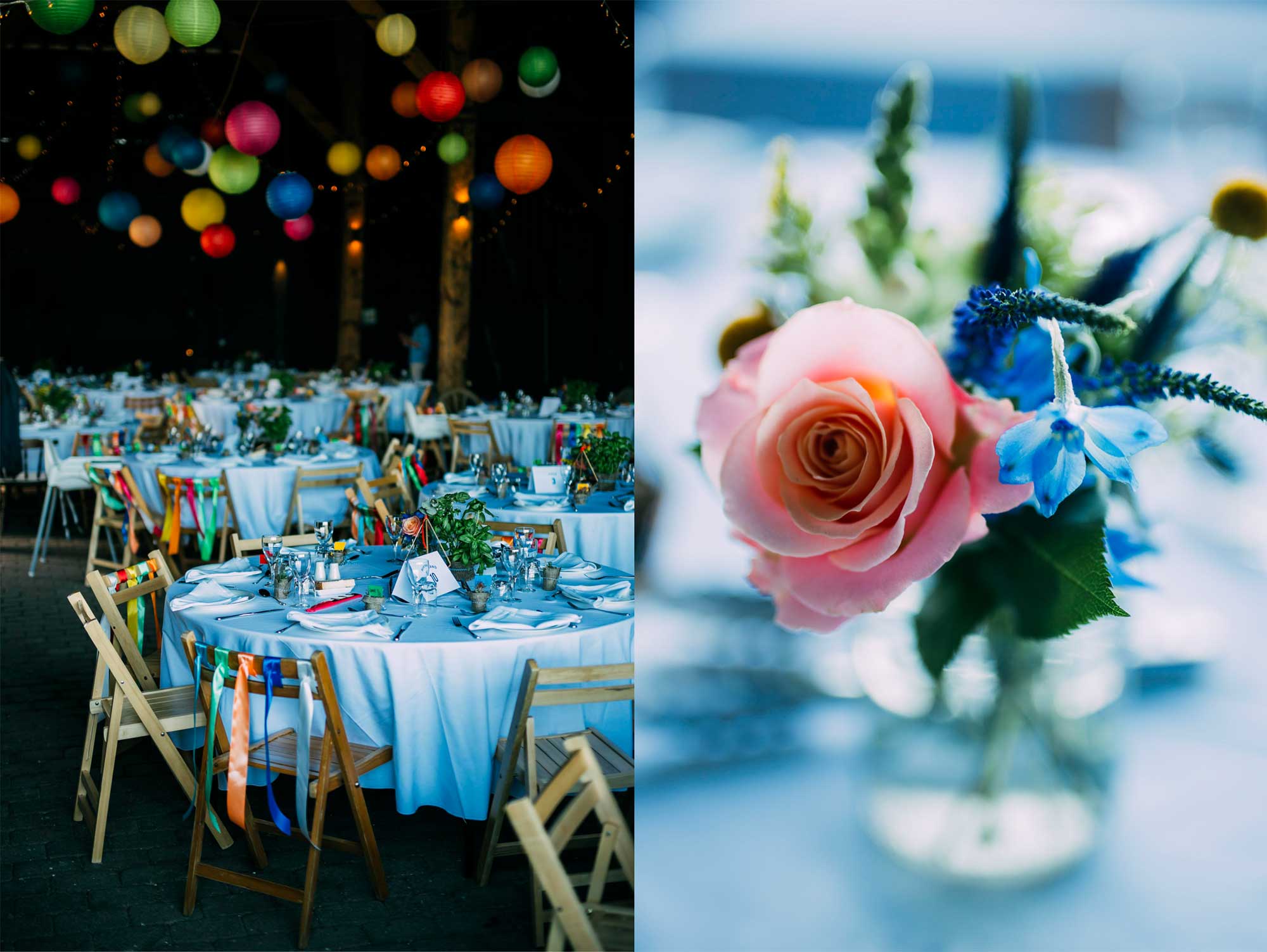
Take the time to photograph these elements, as they will serve as visual touchstones that evoke memories and transport your clients back to their special day.
Capture the finer points, such as the wedding rings, invitations, floral arrangements, and table settings, as well as broader, scene-setting shots of the venue, ceremony space, and reception area.
The best time to photograph the tables is towards the end of the drinks reception. Ask the person in charge of the catering to come and find you when the room is setup. Also ask them to not let guests put their coats and bags on the tables as it looks rubbish.
Showcase Relationships and Connections – The Speeches
The connections between the couple, their families, and friends are a vital part of any wedding story. To convey these relationships, focus on capturing the interactions and shared moments between loved ones. Look for group hugs, shared laughter, and quiet moments of reflection.
The speeches are a great way to capture groups of laughs, because the crowd has a fixed focal point – the speaker. Position yourself behind the speaker looking out into the crowd. The speaker in the foreground gives context to the picture.
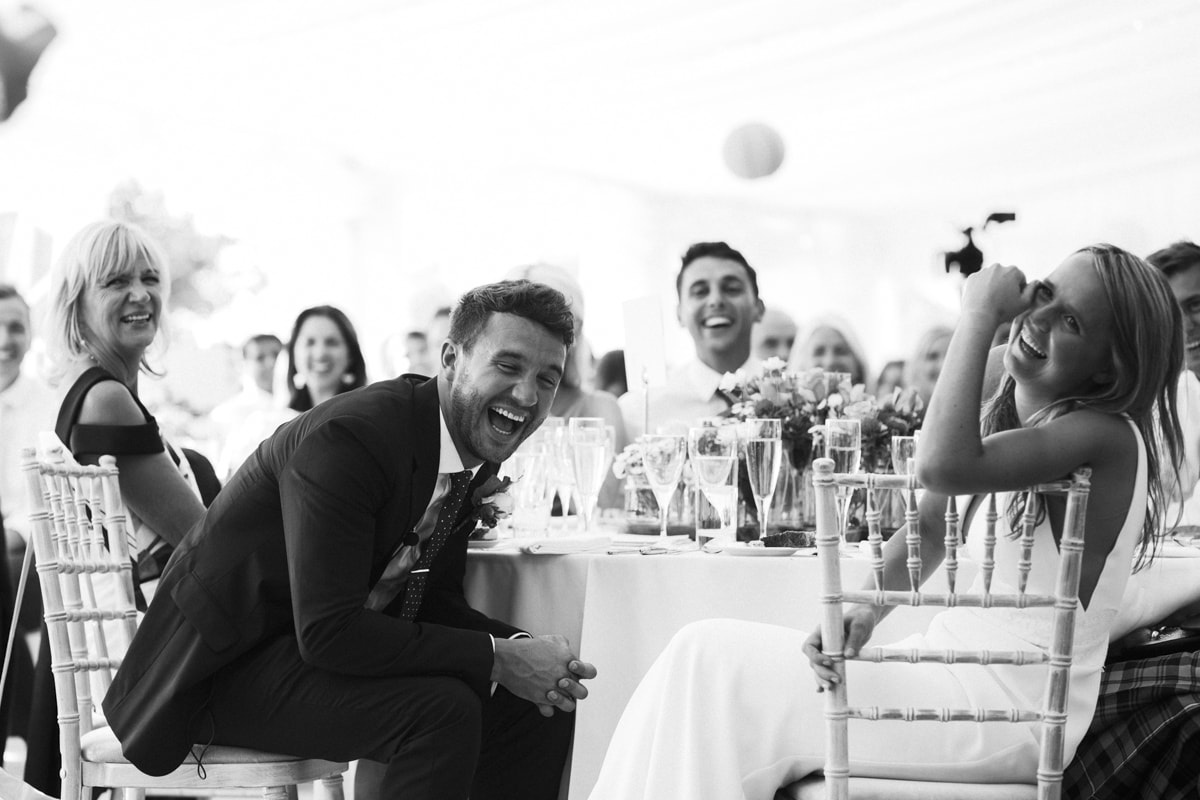
Remove any obstructions before the speeches start. Wine bottles and big flower centrepieces are the worst for this. People tend to move around when they laugh so you need to be sure that they won’t be obscured by table decorations.
Moment gold – don’t stop taking pictures when the speeches are over. When people have finished speaking watch them go back to their seat. often the crowd will give them a pat on the back etc. and when they sit down their child or partner will often embrace the to say well done. These moments are often the best.
Dancing
The dancing is basically a free for all, and you have to get in the thick of it otherwise your pictures will be from the perspective of an outsider looking in, rather than from the point of view of someone who was at the party.
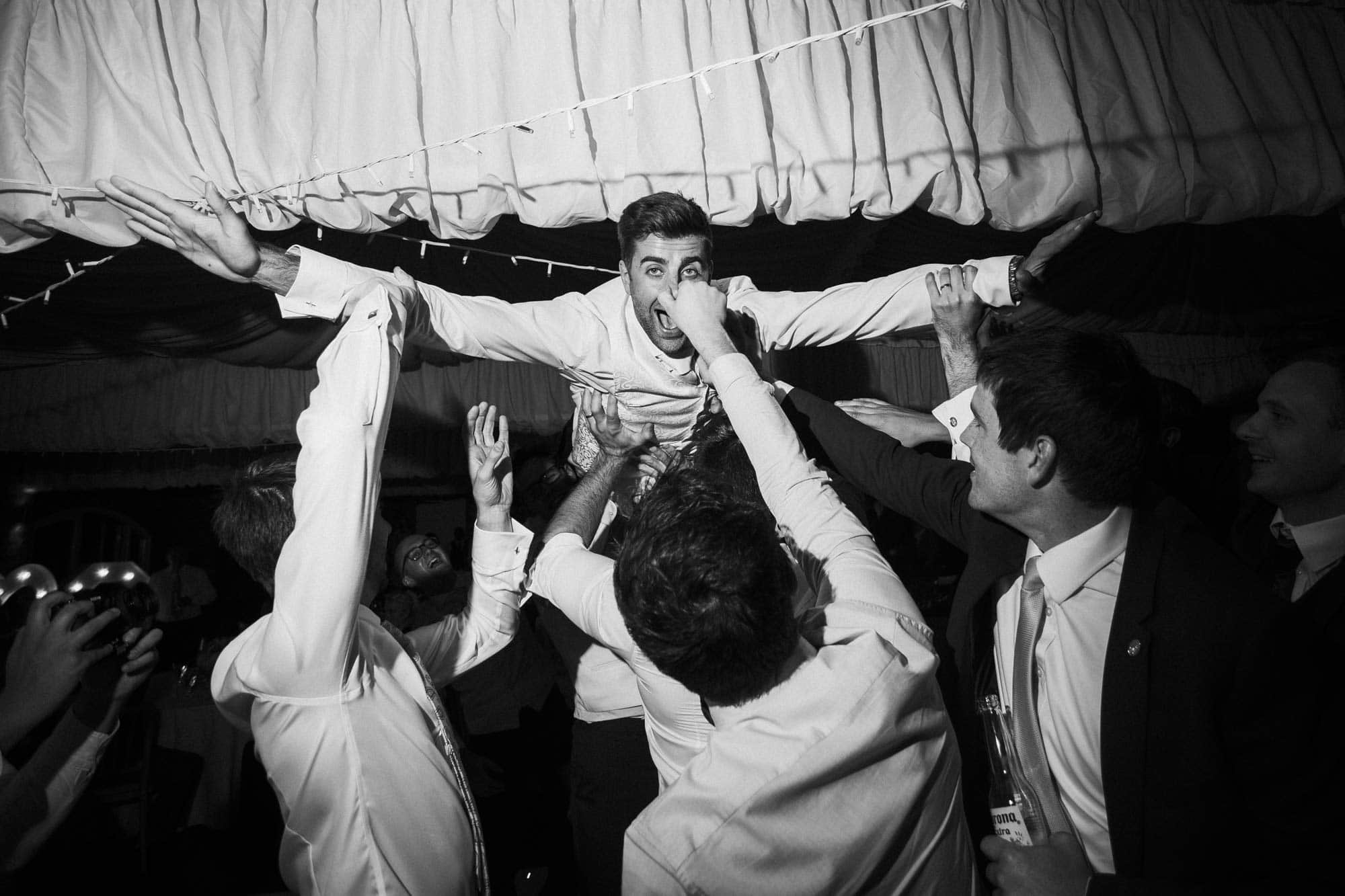
Pay attention to the timeline
A well-constructed wedding story follows a clear timeline, from the early morning preparations to the late-night celebrations. By documenting each stage of the day, you’ll create a sense of progression and a coherent narrative that unfolds like a storybook.
Sometimes a moment wont feel like a moment, but you have to take the picture anyway because it will give you a means to construct the narrative when editing your photographs.
Guests moving from place to place, taking their seats or just generally being in a place. These photographs will help move the narrative forward when you’re making a slideshow. Otherwise the story can feel jumpy and lacking in cohesion.
Find Unique Perspectives
To create a truly compelling wedding story, look for unique angles and perspectives that showcase the day in a fresh and interesting way.
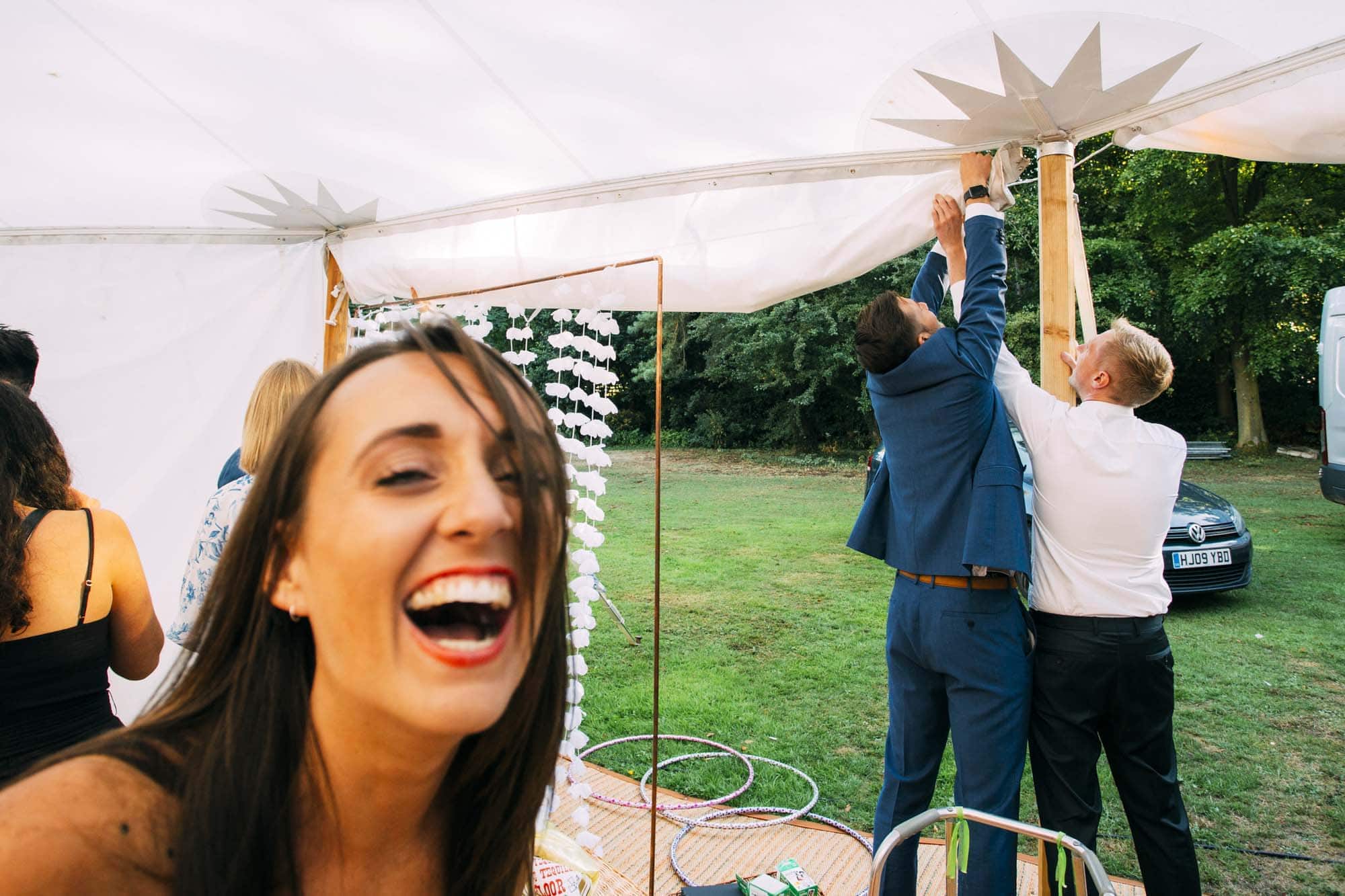
By exploring new perspectives and pushing your creative boundaries, you’ll develop a distinctive storytelling style that sets your wedding photography apart and resonates with your clients.
You need these stand out shots to break up the story.
If all of your pictures are from the same height, at the same focal length and with the same camera settings, when you put them together in a slideshow it will become repetitive and boring. Make sure you’re experimenting with different settings, camera formats and lenses. You can intersperse these shots into the slideshow which really helps to jar the viewer back into the story and keeps them engaged.
Shoot and Edit with the Narrative in Mind
The post-production process is a crucial part of crafting a cohesive wedding story. When selecting and editing your images, keep the narrative in mind and choose photographs that contribute to the overall story arc.
Arrange your images in a logical order that follows the timeline of the day and highlights key moments and emotions. Be selective, ensuring that each image adds value to the story and helps to convey the unique narrative of the couple’s special day.
Research the work of old masters
Adding to the importance of storytelling in wedding photography, it is crucial for photographers to conduct thorough research into the masters of photojournalism. By delving into the work of these renowned photographers, you can gain valuable insight into their techniques and approaches to capturing poignant moments and conveying compelling narratives. Studying these masters can inspire you, challenge your preconceptions, and ultimately help you find your own unique style.
Some of the greats in the realm of photojournalism include Henri Cartier-Bresson, Robert Capa, and Dorothea Lange. Each of these photographers had their own distinct approach to capturing images, which can serve as valuable lessons for wedding photographers aiming to develop their storytelling abilities.
Henri Cartier-Bresson, often hailed as the father of modern photojournalism, was known for his ability to capture what he called “the decisive moment” – the precise instant when an event, emotion, or action was at its peak. Studying his work can teach photographers the importance of timing, anticipation, and patience in capturing the essence of a moment.
Robert Capa, a war photographer, demonstrated the power of immersing oneself in the story being captured. His famous quote, “If your pictures aren’t good enough, you’re not close enough,” highlights the importance of getting up close and personal with your subjects. This can be particularly valuable when photographing a wedding, as it allows you to capture the raw emotions and connections between the couple and their guests.
Dorothea Lange, a documentary photographer, captured the human condition during the Great Depression with empathy and authenticity. Her work serves as a reminder that every subject has a story worth telling and that, as photographers, we have a responsibility to approach our subjects with sensitivity and respect.
When studying the work of these masters, it’s important to break down their images with careful analysis. Consider the composition, lighting, timing, and the emotions captured in each photograph. Reflect on how these elements come together to tell a story and what you can learn from their techniques to apply to your own wedding photography.
By examining the work of these masters and understanding the principles that guided their storytelling, you can begin to refine your own unique approach to wedding photography. Embrace the lessons learned from their work and use them as a foundation upon which to build your own storytelling style. As you develop your voice and perspective as a wedding photographer, your ability to capture the essence of a couple’s special day in a way that resonates with them will only continue to grow.
Conclusion
In conclusion, the art of storytelling in wedding photography is a delicate balance of capturing emotions, details, connections, and key moments while exploring unique perspectives and maintaining a clear narrative. Simple, right? By honing your skills in these areas and approaching each wedding with a storyteller’s mindset, you’ll create compelling visual narratives that your clients will cherish for a lifetime. Remember, as a wedding photographer, you have the honour of telling the story of one of the most important days in a couple’s life – so make it one to remember.
